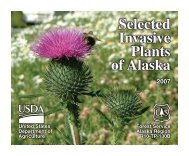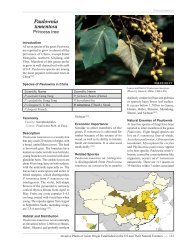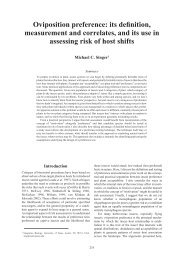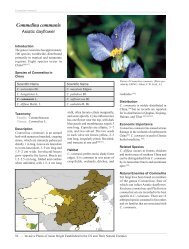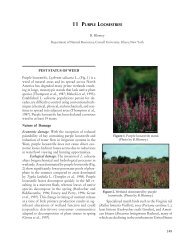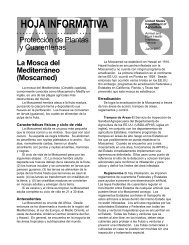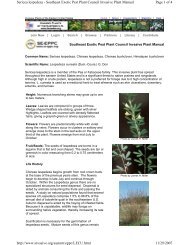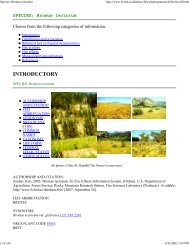A review of literature and field practices focused on ... - Invasive.org
A review of literature and field practices focused on ... - Invasive.org
A review of literature and field practices focused on ... - Invasive.org
Create successful ePaper yourself
Turn your PDF publications into a flip-book with our unique Google optimized e-Paper software.
in the <str<strong>on</strong>g>literature</str<strong>on</strong>g>, in the vast majority <str<strong>on</strong>g>of</str<strong>on</strong>g> cases, m<strong>on</strong>thly cutting fails to eradicate even<br />
isolated <str<strong>on</strong>g>and</str<strong>on</strong>g> relatively small knotweed patches unless c<strong>on</strong>ducted for several years.<br />
However, The Japanese Knotweed Manual (Child <str<strong>on</strong>g>and</str<strong>on</strong>g> Wade 2000) reports successful<br />
c<strong>on</strong>trol <str<strong>on</strong>g>of</str<strong>on</strong>g> an isolated <str<strong>on</strong>g>and</str<strong>on</strong>g> small patch after three c<strong>on</strong>secutive years <str<strong>on</strong>g>of</str<strong>on</strong>g> uprooting the<br />
plants in August. TNC was able to c<strong>on</strong>trol <strong>on</strong>e small patch (25 stems) with 17 m<strong>on</strong>thly<br />
cuttings over three <str<strong>on</strong>g>field</str<strong>on</strong>g> seas<strong>on</strong>s. Child <str<strong>on</strong>g>and</str<strong>on</strong>g> Wade recommend against trying this<br />
technique for larger, more established patches.<br />
So, unless you are prepared to cut knotweed patches TWICE A MONTH OR MORE -<br />
could we say it any str<strong>on</strong>ger? - especially between April <str<strong>on</strong>g>and</str<strong>on</strong>g> August, <str<strong>on</strong>g>and</str<strong>on</strong>g> then <strong>on</strong>ce a<br />
m<strong>on</strong>th or more until the first frost, a program based <strong>on</strong> cutting al<strong>on</strong>e is likely to be a<br />
recipe for frustrati<strong>on</strong> <str<strong>on</strong>g>and</str<strong>on</strong>g> failure. In some cases however, using manual / mechanical<br />
c<strong>on</strong>trol may be the <strong>on</strong>ly viable opti<strong>on</strong> for legal or ethical reas<strong>on</strong>s. For instance, if the<br />
knotweed is in a very envir<strong>on</strong>mentally sensitive area, if a particular l<str<strong>on</strong>g>and</str<strong>on</strong>g>owner is opposed<br />
to pesticide use, <strong>on</strong> some federal l<str<strong>on</strong>g>and</str<strong>on</strong>g>s <str<strong>on</strong>g>and</str<strong>on</strong>g> if labor costs are not an issue.<br />
To be successful, <strong>on</strong>e should plan for an aggressive mechanical c<strong>on</strong>trol program (as<br />
described above <str<strong>on</strong>g>and</str<strong>on</strong>g> below) to be c<strong>on</strong>tinued for at least two or three years if the patches<br />
are well established.<br />
In the end, timely, thorough <str<strong>on</strong>g>and</str<strong>on</strong>g> persistent cutting over several years can eliminate<br />
knotweed, especially small, isolated patches. Because <str<strong>on</strong>g>of</str<strong>on</strong>g> the level <str<strong>on</strong>g>of</str<strong>on</strong>g> effort required, this<br />
approach is really best suited for individual l<str<strong>on</strong>g>and</str<strong>on</strong>g>owners with easy access to their<br />
knotweed patches <str<strong>on</strong>g>and</str<strong>on</strong>g> a str<strong>on</strong>g commitment to avoiding herbicides. Using a<br />
mower/weed-eater is an opti<strong>on</strong> if you can set it close to the ground. It is best to remove,<br />
rake or carefully dry all knotweed vegetati<strong>on</strong> you cut or mow, because stems or stem<br />
fragments can sprout, <str<strong>on</strong>g>and</str<strong>on</strong>g> the area (or adjacent areas) may become re-infested. Do not<br />
allow cut, mowed or pulled vegetati<strong>on</strong> to enter waterways.<br />
Digging or pulling (uprooting) is a good opti<strong>on</strong> if your soil is s<str<strong>on</strong>g>of</str<strong>on</strong>g>t. This will eliminate<br />
some porti<strong>on</strong> <str<strong>on</strong>g>of</str<strong>on</strong>g>, but not all <str<strong>on</strong>g>of</str<strong>on</strong>g> the root system each time you do it. Be sure to carefully<br />
dry or dispose <str<strong>on</strong>g>of</str<strong>on</strong>g> the roots. Do not put them in a compost pile. In Engl<str<strong>on</strong>g>and</str<strong>on</strong>g>, soil<br />
c<strong>on</strong>taminated with knotweed roots is c<strong>on</strong>sidered an envir<strong>on</strong>mental c<strong>on</strong>taminant <str<strong>on</strong>g>and</str<strong>on</strong>g> needs<br />
to be buried 3 meters (10 feet) deep. You will need to follow up frequently as for<br />
cutting/mowing to catch re-sprouted stems. Be sure to search at least 20 feet (7 meters)<br />
away from the original patch center.<br />
There are multiple anecdotal reports <str<strong>on</strong>g>of</str<strong>on</strong>g> c<strong>on</strong>trol attempts using extended covering, but no<br />
reliable reports <str<strong>on</strong>g>of</str<strong>on</strong>g> successful knotweed c<strong>on</strong>trol with covering. This includes those <str<strong>on</strong>g>of</str<strong>on</strong>g> the<br />
Lummi Nati<strong>on</strong> in Washingt<strong>on</strong>, who combined digging, tilling <str<strong>on</strong>g>and</str<strong>on</strong>g> covering with several<br />
layers <str<strong>on</strong>g>of</str<strong>on</strong>g> cardboard <strong>on</strong> 2, ¼ acre patches. The results were poor however; they achieved<br />
<strong>on</strong>ly 80% reducti<strong>on</strong> in stem number, at a cost <str<strong>on</strong>g>of</str<strong>on</strong>g> $32,000/acre. An effort to c<strong>on</strong>trol<br />
knotweed by covering c<strong>on</strong>ducted by the USFS Mt Hood Nati<strong>on</strong>al Forest in Zig-Zag,<br />
Oreg<strong>on</strong>, also failed, despite extensive pre-covering digging. TNC also failed to achieve<br />
good c<strong>on</strong>trol covering a single large patch for about 6 weeks in the spring. Others have<br />
also reported that knotweed grows out from under the covering material. If you must try<br />
it, this method is likely to work better with isolated <str<strong>on</strong>g>and</str<strong>on</strong>g> smaller patches <strong>on</strong> open terrain.<br />
Plan to leave the covering material in place throughout the growing seas<strong>on</strong> <str<strong>on</strong>g>and</str<strong>on</strong>g> well into<br />
the next. As always, check the site through at least September the following year <str<strong>on</strong>g>and</str<strong>on</strong>g><br />
again the year after.<br />
11




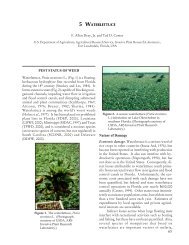

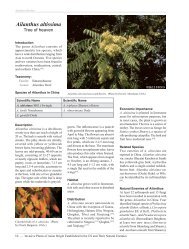
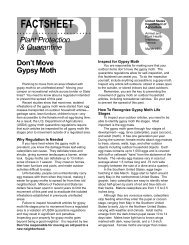
![A Guide to the Control and Management of Invasive Phragmites [PDF]](https://img.yumpu.com/27321025/1/190x190/a-guide-to-the-control-and-management-of-invasive-phragmites-pdf.jpg?quality=85)
